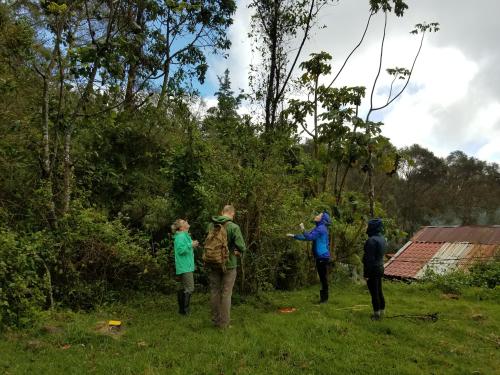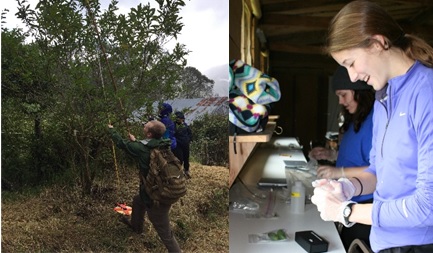
Katie Rudd, Ryan Anderson, Mariah Terhaar, and Noelle Laske measure a nightshade tree and count the number of berries it has produced. This was at our second site, Cuerici/Cerro de la Muerte in a montane cloud forest.
The cost-benefit analysis states that a plant or organism must allocate their resources in a way that is energy efficient while still optimizing essential processes throughout their lifetime. The energy that plants gain is used for two main processes: growth and reproduction. Berry producing plants in particular rely on bird predation of their berries in order to distribute the seed inside. Night shade trees, due to their toxicity to some mammal species, rely entirely on bird dispersal for reproduction. To attract birds, these plants must determine how much sugar to allocate in berry production to maximize reproduction without wasting energy that could be used for growth. Therefore, there is a threshold value when it comes to the optimal sugar percentage. To further explore this concept, we examined the berry abundance and percent sugar content per berry of night shade trees of varying heights and trunk areas. It was hypothesized that as the tree height and trunk area increases, the number of berries would increase significantly. We also hypothesized that as tree height and trunk area increases, the percent sugar per berry would increase significantly until reaching their threshold. A larger is more likely able to obtain more nutrients to produce a larger amount of berries with a higher sugar concentration can focus more on reproduction than growth. Smaller trees are more likely to produce less berries with lower percent sugar because most of their energy is dedicated to maximizing their growth. To test our hypotheses, we examined the number of berries, trunk area, and percent sugar per berry among 10 trees of varying heights. After counting every individual berry on the tree, 15 berries were selected at random and split into groups of 3 and run through a digital refractometer with the average percent sugar content recorded at the end. Circumference and height were measured manually. The collected data was run through several bivariate linear regression models using JMP Pro 13 software. It was determined that our original hypothesis was partially correct, with the number of berries significantly increasing as tree height and trunk area increased. However, the percent sugar content per berry among trees of varying sizes remained relatively constant and showed no significant correlation. Regardless of tree size, we determined that berries will have consistent amounts of sugar. Once a tree has matured enough to dedicate nutrients towards reproduction, it will produce as many berries, each with this set amount of sugar, that is feasible for its size. This experiment gave us insight into the trade-off between reproduction and growth for night shade plants, with our methods applicable to other fruiting species of plants and research on their tradeoffs.

Improvised field equipment and lab space was the norm in the remote cloud forests of Cuerici.
Leave a comment